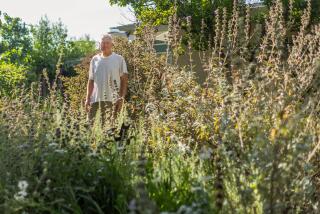If kale is king, then collard greens are prince of the edible garden
- Share via
Kale, the king of greens, has been losing plot real estate to a close relative, collards. With better resistance to heat, collard greens do just fine in Southern California. And the occasional winter cold snap? It only makes collard greens sweeter.
Half a world away, in the Kashmir Valley of India, the plant is often eaten roots and all, flavored by hot peppers and a ground spice called asafetida. Closer to home, collard greens are associated with Southern cooking, combined with Hoppin’ John, the black-eyed peas and rice dish, for a New Year’s tradition said to ensure good luck.
At Vermont Square Community Garden in L.A., Ludella Leonard walks to her car carrying an armload of fat meaty leaves, just harvested from the garden.
“They’re not hard to grow,” she says. “You can get seeds or the plants. They go year-round and take very little water. They just go. But you have to pick them. The large leaves can get old.”
Fellow gardener Clemmy Laday has a huge bunch of leaves she’s taking home. She harvested them from a tree collard in her plot.
“You roll them up like a cigar and cut them lengthwise, fine,” she says. “Black people, they like pork and vegetables. Ham hocks. Smoked turkey necks. You hip to that?”
Collard greens (Brassica oleracea, Acephala cultivar group) originated in western Europe as a wild cabbage. That eventually resulted in a group of cool season crops, including cabbage, Brussels sprouts, broccoli, cauliflower and turnip.
Collard greens seeds are easily available from sources such as the Sustainable Seed Co. They can be sown now -- half-inch deep, 6 inches apart, and later thinned to 18 inches apart -- for harvest in early summer.
Those who prefer their collards eaten young and tender can sow in succession: Plant a portion of your seeds every two weeks, so the greens mature at different times and provide a continual harvest. The soil should be rich and fed monthly with compost tea or a liquid fertilizer.
More good reasons to sow now: The plant’s two main pests, aphids and cabbage worms, aren’t prevalent yet. You also can propagate a seedling from a 6-inch cutting taken from the tip of a plant. Strip it of all but a few of the top leaves, and half-bury it in the dirt.
Once established, collards can get thick as a bush and grow several feet high, depending on the variety. Tree collards (available at Green Thumb Nursery in Canoga Park) can get 10 feet high and live for more than a decade. They are a subset of collard greens with a strong following, particularly among permaculture gardeners who appreciate their longevity.
The Global Garden, our series looking at multicultural L.A. through the lens of its landscapes, appears here on Tuesdays. We welcome story suggestions at [email protected].
You can find L.A. at Home on Facebook, Twitter and Pinterest.






